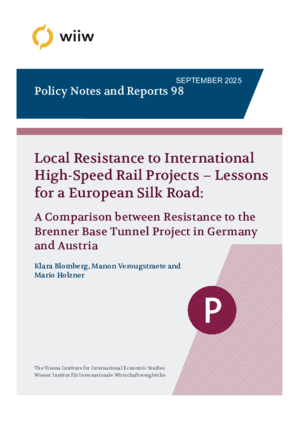Local Resistance to International High-Speed Rail Projects – Lessons for a European Silk Road: A Comparison between Resistance to the Brenner Base Tunnel Project in Germany and Austria
Klara Blomberg, Mario Holzner and Manon Verougstraete
wiiw Policy Note/Policy Report No. 98, September 2025
28 pages including 5 Figures
This report investigates the issue of local actors resisting the implementation of high-speed rail (HSR) routes through the example of reactions to the Brenner Base project in Germany and Austria. In order to understand the causes of significant resistance, the report contrasts reactions to the Brenner Base Tunnel (BBT) in Germany, where resistance and consequent delays are substantial, with reactions to the BBT in Austria, where resistance and delays are more limited. After tracing the evolution of local resistance in both countries, we confirm an important contrast between resistance in Germany and Austria. Our interviews with six Deutsche Bahn (DB) employees and an analysis of local news sources enable us to identify the politicisation of the project by local politicians as a primary cause of greater resistance in Germany.
Our interviewees also pointed out the role of policy changes in tackling the problem of local resistance. It was highlighted that changes such as the 2017 Requirements Plan Implementation Agreement – which increased national authority over this kind of large-scale infrastructure project – may help to simplify future projects and reduce resistance to them.
Learning lessons from failures in constructing large cross-border infrastructure is instrumental for the planning of bold, trans-European rail projects, as envisaged in the European Silk Road initiative.
Among these lessons is the importance of anticipating and integrating localised dynamics and concerns into the planning process. Equally crucial is ensuring the early and balanced involvement of all key countries, as this fosters shared ownership and helps to reduce asymmetries in stakeholder engagement.
Keywords: European Silk Road, high-speed rail, railway transport, infrastructure planning
JEL classification: H54, L92, O18, R41, R42
Countries covered: European Union
Research Areas: Sectoral studies
